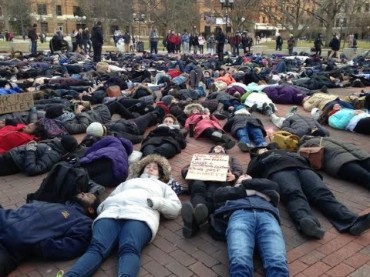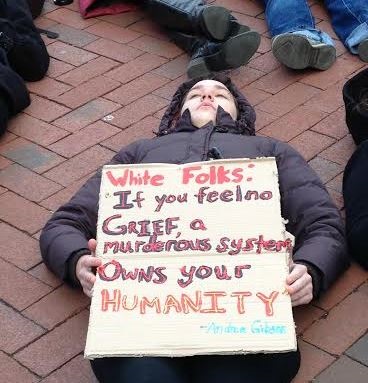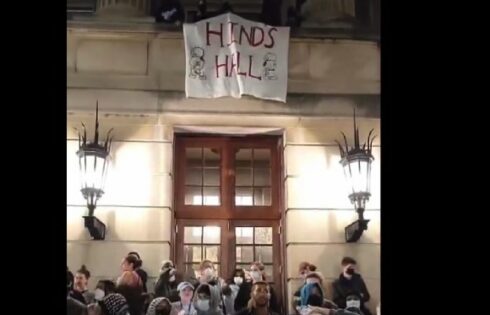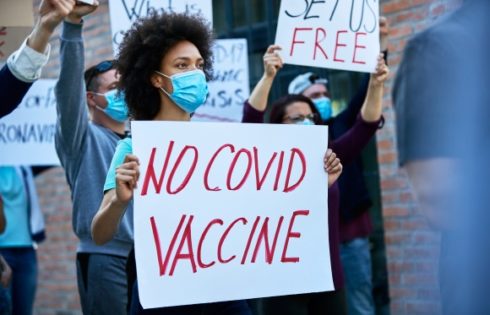
ANALYSIS: University of Michigan ‘die-in’ may have been Instagram gold, but that’s all it was
ANN ARBOR, Mich. – Last Wednesday’s “die-in” protest at the University of Michigan was received with mixed reviews, with questions asked about the nature of the protest and the message it tried to convey.
Was it worth it to make race the focus – as opposed to a more inclusive demonstration against police brutality toward all people? Was it necessary to call out potential white protesters as “members of the oppressing party” the day before the protest, while specifically handing the reins of the protest over to groups such as the Black Student Union and the local NAACP chapter? Was it a mistake to focus on #BlackLivesMatter instead of #AllLivesMatter?
It definitely turned off Kayla Garthus, a junior who was “extremely supportive” of the protest as it was originally advertised.
“I know many of my colleagues, my peers, were willing to come to this event initially based on their belief that white people, just like all people of color, could stand together in solidarity under the term ‘humanity’ over an extremely volatile issue,” she said. 
That sentiment changed following racially charged Facebook posts announcing the event’s three white student organizers had handed the event over to black student groups, with the top comment being a link describing how white protestors should act in order to be “good white allies.”
“My fear was coming and being labeled a ‘racist’ and an ‘oppressor’ simply by my race, my color,” Garthus told The College Fix. “So I felt uncomfortable participating in this event.”
No more than a couple hundred people actually participated in the “die-in,” a far cry from the 1,700 who originally said they were going to attend on Facebook.
Facebook events are known to overestimate the amount of actual attendees, and it’s hard to say if the protest’s racial tilt had any effect on turnout. But Garthus was not the only potential protestor dissatisfied with the focus on race instead of police brutality.
“Why does the leader have to be African American?” asked one protestor on Facebook. “By continuing to separate and segregate, we create an us vs. them attitude in the minds of both groups.”
Jamie Thomson, a student from Detroit-Mercy who was also rubbed the wrong way by the explanation of the original organizers for stepping down, offered an interesting perspective.
“As a black student on campus, I want to know what the majority of my peers feel about these issues because as a black American, I already know how this affects my life,” she explained on Facebook. “Everyday I hear and see black people speak about it and react to it, but it would truly make all the difference for me to hear from others on these issues.”
And in the aftermath of the demonstration, a student expressed her frustration by posting on the event’s wall: “I was incredibly disappointed…we should have taken to the streets…I will next time steer clear of student protests that are more about the pictures than the protest…we couldn’t even hear the speakers…we need to do better…”
Which brings us to the protest itself. “More about the pictures than the protest” rings incredibly true. It was a spectacle for sure, and it effectively blocked off an area that normally experiences the heaviest amount of foot traffic on campus.
“The goal to have it in the diag was to infringe people’s line of walking, sort of like a symbol of more of like a greater idea that a lot of people just in their daily lives, for example, in these urban communities, they can’t walk peacefully each day, or at least that’s somewhat, I think, how they feel,” freshman Kevin Wolf, who said he helped out with the event, told The College Fix.
While it did provide a field-day for amateur photographers, who could be seen walking through the grave of “dead” protestors to get close up shots, it also placed a clear emphasis on the artistic over the political.
The only thing it really accomplished was to “raise awareness.” What it did not do was identify specific causes of injustices, nor provide potential solutions.
Should we look toward demilitarizing the police, for example?
“No,” Wolf told The Fix. “I think that there is a reasoning for (police militarization), and it makes sense. I think a demilitarized police just sounds like…it’s like going back to the 20’s when police were outweighed by bad people.”
Well then, maybe make body cameras mandatory for officers?
“I have a limited amount of knowledge of what organizations such as CopWatch have to say. I would probably refer to them for any real solutions,” freshman die-in protestor named James said in an interview.
Indeed the only remedies suggested were of the vague and ambiguous variety.
“The system needs to be either rewritten, some laws need to be re-passed, but there is no quick-fix,” said William Royster, a member of the Black Student Union.
Therein lies the problem.
Every protestor seemed to agree that “society is somewhat broken and needs fixing,” as stated by Wolf, but nobody seems too concerned about finding a fix. And while the “die-in” may have been Instagram gold, those digging for answers struck nothing at this event.
Instead, we found “dead” protestors arising from the afterlife every few seconds to text. We found a protestor holding a sign that read #JusticeForJohnCrawford,” and then when pressed on the incident he was referring to, admitted “it may not be the best example of police brutality.”
Many, if not most, of the protestors seemed content to protest for the sake of protesting. None of this is to minimize the issue at hand; police brutality is unquestionably an issue of the upmost importance. When citizens of a country are roundly afraid of the very people who are supposed to “protect and serve” them, there is a problem, one that should not be taken lightly.
But this protest failed to hit the mark.
Was it because the protest lacked a clear, impactful purpose? Was it because of the insistence on making it a racial issue?
“I definitely felt as though it detracted from potentially a larger meaning in this,” Garthus said.
Tellingly, she provided the most pointed response of anyone when prompted for solutions to this issue.
“Giving police military-grade weaponry is completely negligible to human rights, not to mention the war on drugs that has perpetuated through the nation, especially in inner city areas, also does not help police brutality issues, especially with people of color,” she said.
This is what the protest missed when it focused on #BlackLivesMatter instead of #AllLivesMatter.
This is what is left out when the focus is on “white privilege” instead of “blue privilege,” as nationally syndicated black radio host Charlamagne Tha God claimed last week.
When potential white protestors are ostracized as “members of the oppressing party,” the protest loses the potential for students of all races to spread ideas that could actually make an impact.
As it happens, another protest titled “I CAN’T BREATHE” has been planned for MLK Day, Jan. 19. The event description reads:
“The issue of police brutality is not a black issue…it is everyone’s issue…it is the police state that we have allowed to sneak up and drain us of our constitutional rights.”
It’s a message hopefully everyone can get behind.
College Fix contributor Hunter Swogger is a student at the University of Michigan.
Like The College Fix on Facebook / Follow us on Twitter
IMAGES: Hunter Swogger/The College Fix





Please join the conversation about our stories on Facebook, Twitter, Instagram, Reddit, MeWe, Rumble, Gab, Minds and Gettr.